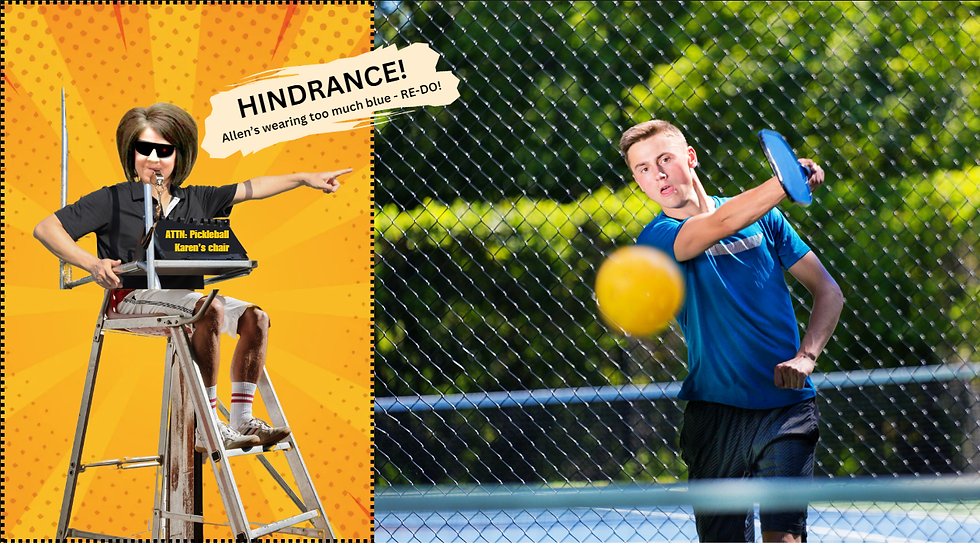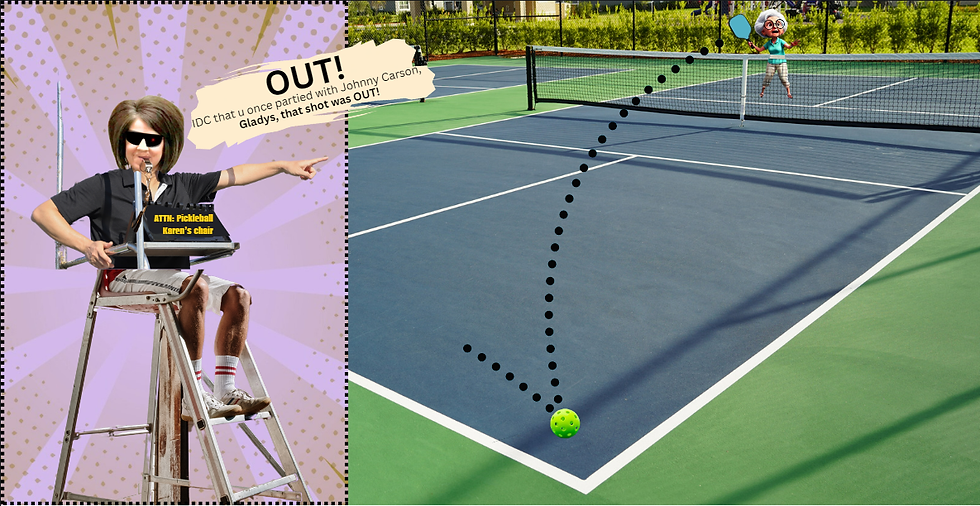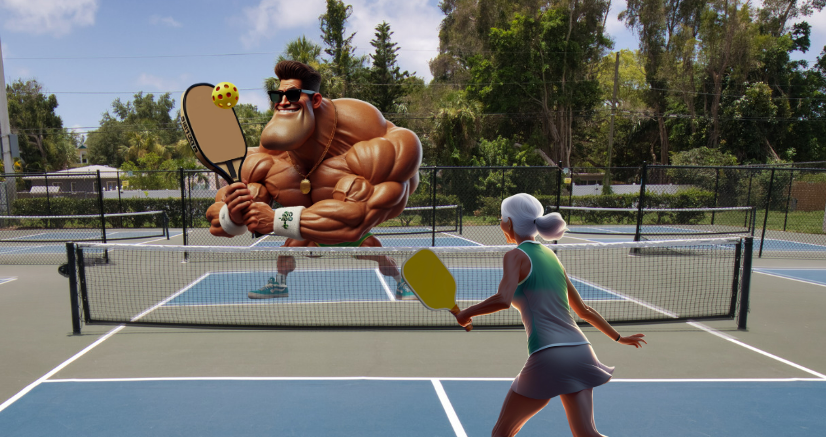Pickleball Karen’s 7 Ways to Demand a Re-Serve After You’ve Lost the Point
- Pickleball_Karen

- Oct 7, 2024
- 5 min read

Pickleball Protocol : Karen's Way or the Highway
Hello, fellow pickleball enthusiasts, rulebook aficionados, and anyone who understands that losing gracefully is just losing with extra steps. Today, we're going to delve into the sophisticated art of demanding a re-serve—because why settle for a mere defeat when you can transform that soul-crushing moment into a magnificent encore performance? Grab your clipboards, adjust your visors, and brace yourselves as we explore the fail-proof methods to ensure that justice—by which I mean, my definition of justice—always prevails on the pickleball court. And remember: demanding a re-serve isn’t just a strategy; it’s a lifestyle choice.
1. Blame External Distractions
Is that a leaf blowing across the court, or is the universe itself conspiring against me? Either way, it's reason enough for a re-serve. Anything can be an “external distraction,” if you’re dramatic enough. The sun’s angle, a rogue gust of wind, or even a passing plane disrupting the sacred silence of the serve—these are all worthy justifications for a do-over.
Heck, if you really want to go the extra mile, claim you saw a shadow of a bird in your peripheral vision. Bonus points if you say it was an endangered species, as it shows that you’re not just a petty rule-sticker, but an environmentally-conscious one. The key here is to present your distraction as life-altering, even if it’s a barely perceptible rustling in a bush 300 yards away. After all, justice knows no hearing range—or sight lines.
2. "Your Serve Was Illegal, Janice!" Always be First to Point a Finger
Remember, when in doubt, bring up the serve. The serve is a Pandora's box of potential complaints—why not open it? Too high? Outrageous. Too low? Absolutely illegal. Too accurate? Clearly suspicious. I recommend keeping a mental dossier on each opponent’s alleged foot faults, questionable spins, and dubious wrist angles, even if they serve with the precision of a NASA engineer launching a space probe.
And don't just accuse; educate. Casually throw in technical jargon like “double-bounce syndrome” or “latent spin trajectory.” Watch their eyes glaze over as they wonder if you’re making it all up. (You are, but they don’t need to know that.) The important thing is that you look outraged and slightly condescending, as if you’re only just now realizing that your opponent has been committing serve violations your entire life.
3. Question Line Calls Retroactively
Ah, yes, the art of revisionist history. Why accept a line call when you can retroactively decide it was wrong? It’s amazing how a perfectly fine call becomes wildly questionable the instant it costs me a point. If the ball was anywhere near the line, we’re entering the wonderful world of “Was that really in?” Revisit these moments with newfound conviction, the kind that only blossoms after you realize you lost the point.

"But Karen," you might say, "won't people notice I didn't speak up right away?" First of all, how dare you question my integrity. Second, let me remind you that my hesitation was just saint-like restraint on full display. I was trying to be polite by not immediately challenging every call with a dramatic flourish. But now? Now I have no choice but to bravely seek out the truth—retroactively.
4. Feign Equipment Malfunction
Oh, the devastating betrayal of your paddle malfunctioning at the exact wrong moment. What are the chances, right? Answer: 100%, when you plan ahead. A good equipment malfunction is essential for demanding a re-serve with credibility. The best part is, anything can be an “equipment malfunction” if you’re creative enough. Did the grip feel slightly too slippery, or perhaps the paddle didn’t “bounce back” the way you expected? Boom—instant re-serve grounds.
Don’t be afraid to get dramatic here. Inspect your paddle like Sherlock Holmes looking for fingerprints, grimacing at the tape, sighing heavily, and shaking your head. Maybe even give it a couple of gentle taps on the court to “test the bounce.” The trick is to appear genuinely dismayed at your paddle’s inexplicable behavior—while still managing to look incredibly composed, because we both know it was planned all along.
5. Pretend to Misinterpret the Rules
If at first, you don’t succeed, complicate. Pickleball has enough rules to make the IRS blush, so why not take advantage of that? Make up a delightful misinterpretation of some obscure subsection and announce it with the confidence of a Supreme Court judge handing down a ruling. Something like, “As per subsection 12B, paragraph 4, any serve rotating more than 17 degrees counterclockwise is clearly invalid. Everyone knows that, Brad.”
Pro tip: Use big words and obscure terms. Most people won’t even bother to argue with you if you sound smart enough. It’s surprising how often “complexity” is mistaken for “competency.” If they ask to see proof, just sigh, roll your eyes, and lament how nobody reads the bylaws these days. I mean, really—why am I the only one carrying a laminated copy of the rulebook in my gym bag?
6. Call for a “Spirit of the Game” Violation
Ah, the Spirit of Pickleball—that elusive, abstract concept as useful as it is vague. The brilliance of invoking it is that it doesn’t really mean anything, but it feels important. If your opponent’s aggressive play disrupts your delicate state of mind, or if they’re rushing you, then it’s clearly a violation of the game’s sacred spirit.
Did they hit the ball too hard? Spirit violation. Did they look at you with that face? Spirit violation. Did they not wait the universally accepted 7.3 seconds before resuming play after your perfectly timed equipment malfunction complaint? Spirit violation. No one can argue against something as nebulous as the “spirit” of a sport. It’s the athletic equivalent of arguing over someone’s aura color. And guess who gets to decide what pickleball’s spirit really is? That’s right—me. Always me.
7. Stage an Injury (But Only After Losing)
When all else fails, and you’ve exhausted every obscure rule and complaint possible, it’s time to break out the big guns: the fake injury. But not just any injury—this has to be Oscar-worthy. A little limp here, a gentle massage of the shoulder there. Nothing too severe, mind you. We don’t want to overplay our hand—just a believable level of discomfort that suggests, “Had this injury occurred before that last point, I would have won, hands down.”
The timing is key. If you go down before losing the point, you look like you’re making excuses. But afterward? That’s just a perfectly timed setback. The beauty of the fake injury is that it demands sympathy while also providing a bulletproof excuse for demanding a re-serve, and if they still refuse? Congratulations, you’re now the moral victor who valiantly struggled through adversity, despite the heartlessness of your opponent.
By mastering these techniques, I ensure that the sanctity of the game—and my ego—remains intact. Let no simple “loss” stand in the way of exacting true, Karen-approved fairness. Remember, it’s not just about winning the point; it’s about showing that you’re the kind of person who demands a level of perfection in the game that others can only dream of achieving.
So there you have it, folks. Why settle for losing a point when you can rise from the ashes of defeat like a majestic, rule-quoting phoenix? Now, it’s your turn to take these methods out for a spin and demand the re-serve you deserve. Go forth and disrupt the pickleball status quo. And while you're at it, make sure you subscribe to my blog—because pickleball perfection doesn’t just happen. It requires guidance, wisdom, and, of course, me.
Follow these steps, share them with your court buddies (or better yet, opponents), and join the movement toward a Karen-approved future where no loss goes unquestioned, and every serve has the potential for a glorious redo. You’re welcome in advance.







Comments